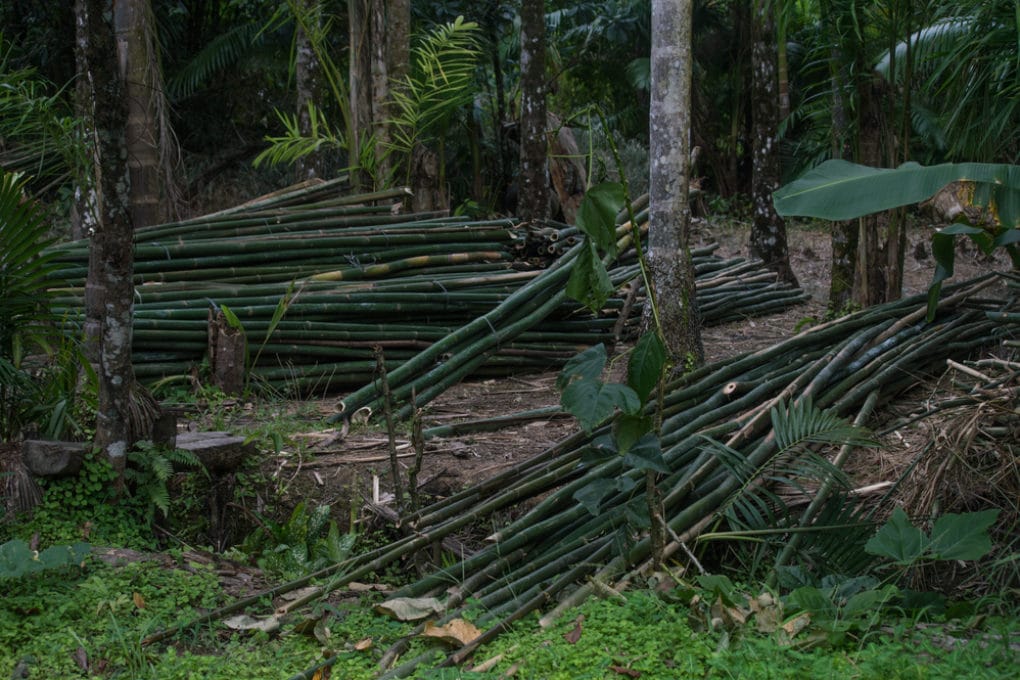How To Kill Bamboo: A Comprehensive Guide For Effective Removal
So, you've decided to tackle the notorious bamboo invasion in your yard. Let's be real, bamboo is like that one friend who just won't leave your life even when you've politely asked them to move on. But don't worry, we're here to help you out. Killing bamboo might sound like an impossible mission, but with the right tools and techniques, you can get rid of it once and for all. Whether you're dealing with a small patch or a full-blown bamboo jungle, this guide has got you covered.
Now, before we dive into the nitty-gritty details, let's talk about why bamboo removal is such a big deal. Bamboo is not just any plant; it's a relentless grower that can spread faster than you can say "bamboo." If left unchecked, it can take over your entire yard, invade neighboring properties, and even damage your home's foundation. That's why learning how to kill bamboo is crucial for maintaining a healthy and manageable landscape.
In this article, we'll walk you through everything you need to know about bamboo removal. From understanding the different types of bamboo to exploring various methods of eradication, we've got all the tips and tricks to help you win the battle against this invasive plant. So grab your gardening gloves, and let's get started!
Read also:Joseacute Coacuterdoba The Rising Star Taking The World By Storm
Here's a quick rundown of what we'll cover:
- Understanding Bamboo Types and Growth Patterns
- Why Bamboo Removal is Necessary
- Tools You'll Need for Killing Bamboo
- Step-by-Step Guide to Kill Bamboo
- Chemical Methods for Bamboo Eradication
- Organic Alternatives to Chemicals
- Preventing Bamboo Regrowth
- DIY Tips for Long-Term Control
- Common Mistakes to Avoid
- When to Call the Professionals
Understanding Bamboo Types and Growth Patterns
First things first, you need to know what you're up against. Bamboo comes in two main types: clumping bamboo and running bamboo. Clumping bamboo behaves itself and grows in neat little clusters, making it easier to manage. Running bamboo, on the other hand, is the wild child of the bamboo family. It spreads aggressively through underground rhizomes, popping up in unexpected places and wreaking havoc on your garden.
Understanding the growth patterns of bamboo is key to developing an effective removal strategy. Running bamboo can grow up to 3 feet per day, so if you're not on top of it, it can quickly get out of control. Clumping bamboo, while less invasive, can still become a nuisance if not properly maintained. Knowing which type of bamboo you're dealing with will help you choose the right method for killing it.
Identifying Bamboo Species
There are over 1,400 species of bamboo, each with its own unique characteristics. Some common species you might encounter include:
- Phyllostachys aurea (Golden Bamboo)
- Bambusa multiplex (Hedge Bamboo)
- Fargesia nitida (Umbrella Bamboo)
- Chusquea culeou (Southern Chilean Bamboo)
Each species has its own growth habits and preferences, so it's important to identify the type of bamboo growing in your yard. This will help you tailor your removal strategy to the specific needs of that species.
Why Bamboo Removal is Necessary
Bamboo might look pretty and give your garden that exotic, tropical vibe, but let's face it, it can be a real pain in the neck. Here are a few reasons why bamboo removal is necessary:
Read also:Duke Baylor The Rising Star In The Spotlight
- Invasive Growth: Bamboo can spread rapidly and invade neighboring properties, causing disputes with your neighbors.
- Damage to Structures: Running bamboo can damage foundations, driveways, and other structures by growing under them.
- Shade Problems: Dense bamboo stands can block sunlight, preventing other plants from growing.
- Fire Hazard: Dry bamboo can become a fire hazard, especially in areas prone to wildfires.
If you're dealing with bamboo in your yard, it's important to take action before it causes serious problems. The sooner you address the issue, the easier it will be to remove the bamboo and prevent further damage.
Tools You'll Need for Killing Bamboo
Before you start hacking away at your bamboo patch, make sure you have the right tools for the job. Here's a list of essential tools you'll need:
- Pruning saw
- Shovel or spade
- Mattock or pickaxe
- Gloves
- Garden hose or water source
- Herbicide (optional)
Having the right tools will make the process easier and more efficient. Make sure your tools are sharp and in good condition to avoid unnecessary frustration.
Protective Gear
When dealing with bamboo, it's important to wear protective gear to avoid injury. Bamboo can have sharp edges, and the dust from cutting it can irritate your skin and eyes. Here's what you'll need:
- Gloves
- Safety goggles
- Long-sleeved shirt
- Sturdy shoes
Wearing the right gear will help protect you from cuts, scratches, and other injuries while you work.
Step-by-Step Guide to Kill Bamboo
Now that you have all the tools and gear you need, let's dive into the step-by-step process for killing bamboo. This method involves a combination of cutting, digging, and treating the bamboo to ensure it doesn't grow back.
Step 1: Cut Down the Bamboo
Start by cutting down the bamboo stalks as close to the ground as possible. Use a pruning saw or chainsaw for larger stalks, and loppers for smaller ones. Be sure to wear your safety gear while cutting to avoid injury.
Step 2: Dig Up the Roots
Once the stalks are cut down, it's time to dig up the roots. This is the most labor-intensive part of the process, but it's crucial for preventing regrowth. Use a shovel or mattock to dig around the base of the bamboo and carefully remove the rhizomes. Be thorough and make sure you get every piece of root, as even a small fragment can sprout new growth.
Step 3: Treat the Stumps
After digging up the roots, treat the remaining stumps with a herbicide containing glyphosate. This will kill any remaining root system and prevent new shoots from emerging. Follow the instructions on the herbicide carefully to ensure safe and effective application.
Step 4: Monitor and Maintain
Even after you've completed the removal process, it's important to monitor the area regularly for any signs of regrowth. If you notice new shoots emerging, cut them down immediately and reapply herbicide as needed. Consistent maintenance is key to keeping bamboo from returning.
Chemical Methods for Bamboo Eradication
If you're dealing with a large bamboo patch or want a more thorough solution, chemical methods can be effective for killing bamboo. Here are a few options to consider:
- Glyphosate: This is the most commonly used herbicide for bamboo control. It works by inhibiting the plant's ability to produce essential proteins, leading to its death.
- Triclopyr: Another effective herbicide for bamboo, triclopyr works by mimicking a plant hormone that disrupts growth and development.
- Vinegar: For a more natural option, vinegar can be used to kill bamboo. Simply pour it on the cut stumps or emerging shoots to dry them out and prevent regrowth.
When using chemicals, always follow the instructions carefully and take appropriate safety precautions. Avoid using herbicides near water sources or in areas where children and pets play.
Organic Alternatives to Chemicals
If you prefer a more organic approach to bamboo removal, there are several alternatives to chemicals you can try:
- Mulching: Cover the bamboo area with a thick layer of mulch to block sunlight and suffocate the plants.
- Boiling Water: Pour boiling water on the cut stumps and emerging shoots to kill them naturally.
- Salt: Sprinkle salt on the soil around the bamboo to dehydrate the roots and prevent regrowth.
While these methods may take longer to work than chemicals, they're a great option for those who want to avoid using synthetic herbicides in their garden.
Preventing Bamboo Regrowth
Once you've successfully removed the bamboo, it's important to take steps to prevent it from regrowing. Here are a few tips for keeping bamboo at bay:
- Install a Barrier: Place a physical barrier, such as a metal or plastic sheet, around the perimeter of your garden to prevent bamboo rhizomes from spreading.
- Regular Maintenance: Keep an eye on your garden and remove any new bamboo shoots as soon as they appear.
- Plant Competing Vegetation: Plant other plants that can compete with bamboo for resources, making it harder for bamboo to thrive.
By taking these preventive measures, you can ensure that your bamboo problem stays under control in the long term.
DIY Tips for Long-Term Control
If you're looking for more DIY solutions to keep bamboo in check, here are a few ideas to try:
- Prune Regularly: Keep bamboo plants pruned to prevent them from spreading.
- Divide and Transplant: If you want to keep bamboo in your garden but control its growth, divide the plants and transplant them into containers.
- Use Natural Repellents: Experiment with natural repellents like cinnamon or garlic spray to deter bamboo growth.
With a little creativity and persistence, you can find DIY solutions that work for your specific situation.
Common Mistakes to Avoid
When it comes to killing bamboo, there are a few common mistakes that people make. Here's what to avoid:
- Not Digging Deep Enough: Failing to remove all the rhizomes can lead to regrowth.
- Overusing Chemicals: Using too much herbicide can harm other plants and the environment.
- Ignoring Maintenance: Neglecting to monitor the area for regrowth can result in bamboo coming back stronger than ever.
By avoiding these mistakes, you'll have a better chance of successfully eradicating bamboo from your yard.
When to Call the Professionals
If your bamboo problem is too big to handle on your own, it may be time to call in the professionals. A professional bamboo removal service can use specialized equipment and techniques to get the job done quickly and effectively. They can also provide advice on preventing bamboo regrowth and maintaining a healthy landscape.
Don't be afraid to seek help if you need it. Sometimes, calling in the experts is the best way to ensure a successful outcome.
Conclusion
Killing bamboo might seem like a daunting task, but with the right approach, it's definitely doable. By understanding the different types of bamboo, using the right tools and techniques, and taking preventive measures, you can get rid of bamboo once and for all. Remember to stay patient and persistent, as bamboo removal is often a long-term process.
Now that you've got all the information you need, it's time to take action. Whether you choose to tackle the job yourself or call in the professionals, make sure to share this article with your friends and family who might be dealing with the same problem. Together, we can take back our gardens from the bamboo invasion!
And hey, if you have any questions or tips of your own, drop a comment below. We'd love to hear from you!
Article Recommendations


